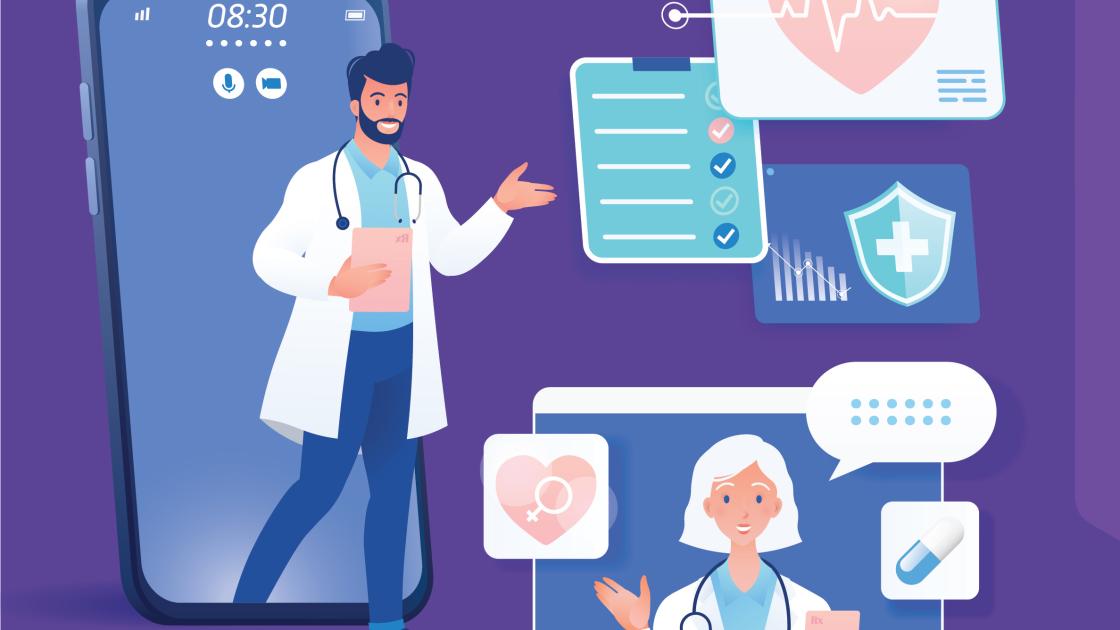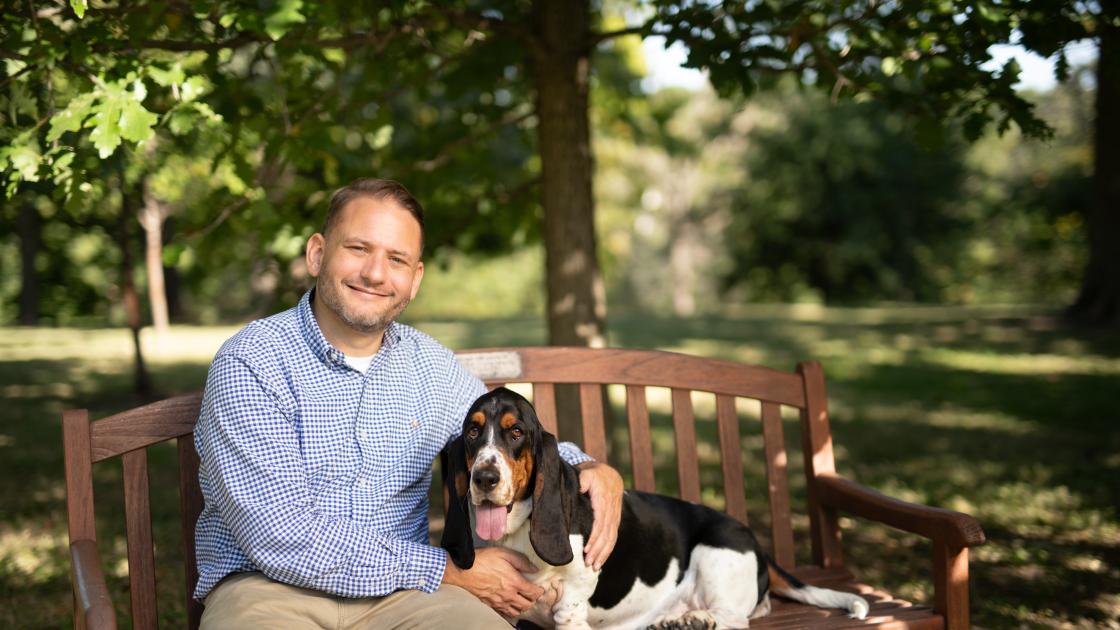
Patient Zero-One
AI drives latest education innovation at SIU Medicine
In a small laboratory on the SIU School of Medicine campus in Springfield, third-year medical student Jake Schmid can see into the future.
His eyes are fixed on the screen as he interviews patient Randy Rhodes, a long-haul truck driver from Carbondale. Rhodes sits in a downstate clinic space identical to the scores of rooms in SIU’s adjacent health care facilities. He discusses his current concerns about his weight and fatigue, while Schmid jots notes and asks follow-up questions to learn more about the middle-aged man on the monitor.
A telehealth visit is nothing new. Groups of SIU providers have been connecting online with patients since 1995. Its use exploded when COVID-19 shut down in-person clinic access in the spring of 2020.
What’s novel about this particular session is the patient. Randy Rhodes is a virtual creation, comprised entirely of digital code and given a level of autonomous artificial intelligence (AI) that can accurately simulate a real human encounter.
Schmid probes the patient for more information, at times choosing his words carefully to trigger more conversational responses. Schmid knows his patient well. He is one of the learners who helped to create Randy.
“The medical students really drove the invention of Randy,” said Richard Selinfreund, PhD. ‘Dr. S,’ as the students call him, is an associate professor and head of the pathology group in the Department of Medical Microbiology, Immunology and Cell Biology. He leads the team that has taken Randy from a concept to the school’s first AI-enhanced standardized patient. But he doesn’t want the credit.
Traditionally, SIU student curricula are designed with its first two years centered in the classroom to prepare learners for clinical experiences in Years 3 and 4. Year 1 introduces them to problem-based learning (PBL), where the students work through clinical cases in small groups to learn the pathology, physiology and pharmacology that goes with each patient. Virtual training exercises begin in year 2.
The text-heavy software was circa 2007. Its old-school stylings grated on students raised with modern gamer sophistication.
“There were complaints our current system was antiquated, and it wasn’t helping them to learn,” Selinfreund said. As a professional problem solver, he saw an opportunity for greater exposure to more frequent, accurate clinical scenarios. “So I just cleared the path so they could get it done.” Like all inventors, Dr. Selinfreund had confidence in his concept. He and his wife, Jacqueline, agreed to fund the program’s start-up.
Patient pioneering, Version 2.0
Cyber-patient Randy Rhodes is part of an innovation lineage at SIU. The medical school revolutionized the use of standardized patients in medical school training in the ‘80s. Neurologist and medical educator Howard Barrows, MD, first began using SPs at the University of Southern California in 1963. As the new SIU School of Medicine associate dean of education in 1981, Barrows expanded the curricula further, including the world’s first professional development lab, or PDL, in 1984.
Forty years after Barrows moved to the Midwest, Selinfreund made a similar leap of faith. A New Mexico native, he had earned his PhD at New Mexico State University/Los Alamos National Laboratory in pathology and cell biology. He followed it with fellowships in cancer research at Yale and Vanderbilt, taught and then worked for a time in biotech, where he learned to write patents. The inventive pathologist shares nearly 70 U.S. and international patents with colleagues across the United States.
Selinfreund was well aware of SIU’s reputation for educational innovation when he was invited to join the faculty in 2021. Scholars at New Mexico State had embraced the school’s problem-based learning approach. “I knew SIU has a culture of advancing medical education,” he said. “And I thought, well, I want to be part of that.”
In his inaugural year, Dr. S heard the students’ griping over the dated computer simulations and looked for ways to remedy it. “We built a video game. We scripted everything. It failed terribly,” he said. The problem boiled down to spontaneity. “You couldn't anticipate what the students would ask, and you couldn’t anticipate how the patient would answer.” A Stanford paper Selinfreund read held the answer: autonomous artificial intelligence. Computers capable of talking to each other can gradually hone their knowledge base.
“[Associate Dean for Research] Dr. Don Torry told me there was a professor down in the English department in Carbondale who knows how to do this. I thought he must be kidding. So I went down and met Pinckney,” Selinfreund said.
Professor Pinckney Benedict is the senior fiction writer in the Creative Writing Program at SIU. He is also the founder and director of the Digital Humanities Lab (DHL) of the College of Liberal Arts, which puts powerful technology for creation in the hands of liberal arts students. His interest in creative writing is paired with a passion for virtual reality, AI and interactive narrative in gaming.
With gentle persuasion, Benedict was convinced to bring the expertise of SIU’s Digital Expression Laboratory on board to develop a better, more life-like patient simulation for medical student learning.
Schmid had taken classes with Professor Benedict as an undergraduate in Carbondale and was delighted when he learned he was joining the team. “He's a creative genius and he is going to make a difference with this cool stuff that he does,” Schmid said.
Learning from the learners
With any computer application, the output is only as good as the input. The project required content readers, renderers and coders. Students were attracted to reinventing a wheel, moving a time-tested component of SIU’s teaching repertoire into the digital age. Converting numerous case files into searchable text is time-consuming but necessary.
“It takes collaboration to make all the PBL cases completely viable and usable,” said Tommy Johnston, an enthusiastic fourth-year medical student on the team. “The ones that provide the students and developers with the most storytelling to work with are favorites, pushing the communication variables in new directions.”
“This is really a tool for teaching the kind of soft skills that aren't prominent anywhere else in the curriculum,” he said. “SIU is known for teaching teachers, and we can make a better tool for teaching communication and interpersonal skills, focusing on the patient-physician relationship, with something that’s truly innovative and interactive.”
Teachable moments have surfaced as the students transcribe the nuances of Randy’s interactions. Though set for neutrality, what if someone detects a tone of irritability in Randy’s voice? Dr. S believes the response is where the value lies: Does the interviewer follow up with a question to probe and learn more or do they move on?
Even introductions can play out in subtle ways. A student may introduce him- or herself as an individual or as part of a team. While the former may seem more personal, Randy's responses may ultimately be more forthcoming if he feels vested with a team of physicians.
Graduate student Akhila Kambhatla is working on sentiment analysis, developing a software code that can evaluate the student simulation interaction in real-time. Specifically, it measures words that increase trust between a patient and a physician.
Medical Education Professor Anna Cianciolo, PhD, is analyzing how learning is affected by the use of generative AI in patient simulations.
“Oftentimes medical education research stops with ‘it worked,’ but the real discovery happens when we ask ‘What worked?’ ‘How?’ ‘Why?’ and ‘What else happened?’” said Cianciolo. “The research we're doing now will inform not only our ideas on Randy's impact but also directions for future AI research and development in our curriculum.”
Randy’s health conditions and personality will get more challenging as the students advance through the training in Years 3 and 4. Confounding comorbidities, mental health problems, suicidal ideation, overt sexism and racism will add to the experience. Some of it will be challenging and unpleasant but real and necessary for training.
The idea is for the students to stumble, practice and regain their footing, using their communication skills to build competence and confidence within the virtual safe space. Randy will learn from the learners and reset for the next encounter, a literal chatbot sharpening itself from each exchange.
Readying Randy to go out in the world
Johnston and Selinfreund have been presenting Randy in demonstrations at national conferences during the past year, generating interest in its availability and innovation.
Johnston said, “I’ve told our audiences, we’re not building a replacement for a bad system. We’re creating something better for the next generation. It’s catching up with the current technology, pushing the bounds and delivering something in addition to the already great things SIU School of Medicine offers.”
As is his wont, Dr. S keeps looking toward the future. “A year from now, no one will care that we made AI-simulated patients. The value comes in the years after that: What do we do next with what we learned, and how do we analyze it? What's the infrastructure?”
“AI will not provide a perfect replica of a patient encounter. But it will come close. And we can make it portable and adaptable for the end user.”
Selinfreund has received continued support from SIU faculty and colleagues, who recognize the project is a potential game-changer. He sees it as part of a tradition.
“I think this medical school knows how to train physicians. They've been training physicians for a long time. And I think most medical schools want to train physicians who can change the world. I'm asking these students to change the world.”
Halfway through medical school, sitting in the learning lab, Schmid feels up to the challenge. “SIU has roots in the problem-based learning curriculum they started in the ‘80s. We're on the new frontier of medical education again. I am really excited by that.”
Over his shoulder, Randy Rhodes is paused, waiting to be asked another question.



